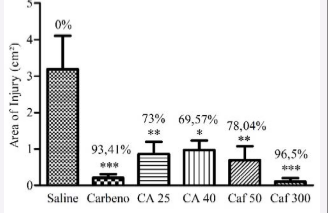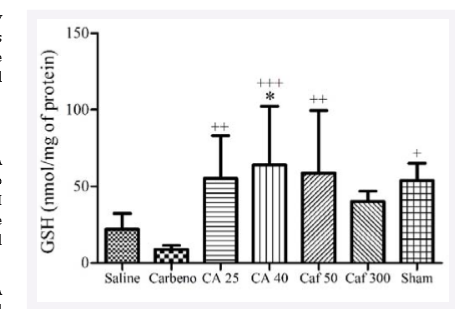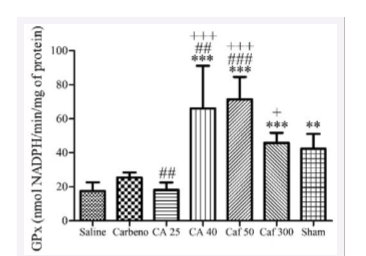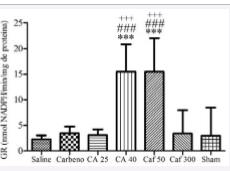Evaluation of the Gastroprotective and Antioxidant Effects of Caffeine and Caffeic Acid on EthanolInduced Gastric Ulcer
- 1. Department of Morphology, São Paulo State University, Brazil
ABSTRACT
Gastric ulcer (GU) is one of the most common disorders of the gastrointestinal tract. Among the nutritional aspects involved in GU trigger process we have the coffee intake. Caffeine (Caf) is one of the most known compounds of coffee, just as caffeic acid (CA) - a metabolic product from chlorogenic acids - and both have high antioxidant activity, which can protect the gastric mucosa, since oxidative stress can trigger the onset of GU. Because that, the aim of this study was to analyze the cytoprotective capacity of Caf and AC in different concentrations in ethanol-induced GU. For this, 56 male Wistar rats were subjected to GU induction and divided into 7 groups: saline 10 mL/kg; carbenoxolone 100 mg/kg; CA 25 mg/kg; CA 40 mg/kg; Caf 50 mg/kg; Caf 300 mg/kg and sham. All animals received the specific treatment, absolute ethanol and then were euthanized. At the end of the experiment, the stomachs were removed and submitted to macroscopic analysis by measurement of ulcerated area and antioxidant activity. The macroscopic analysis revealed significant differences for all treatments compared to vehicle, with Caf 300 and CA 40, showing the best cytoprotection. The biochemical analysis revealed increased levels of GSH, GPx and GR in CA 40 and higher activity of GPx in Caf 300. With our results, we demonstrated the gastroprotective activity of caffeine and caffeic acid, with best results in groups Caf 300 and CA 40 showing the decrease in GU area and the antioxidant potential mediated by GSH and GPx pathways.
KEYWORDS
Gastroprotection ;Antioxidant ;Phenolic compounds ; Cytoprotection ; Gastric ulcer.
CITATION
de Souza MO, Sérgio Gushiken LF, Beserra FP, Pellizzon CH (2017) Evaluation of the Gastroprotective and Antioxidant Effects of Caffeine and Caffeic Acid on Ethanol-Induced Gastric Ulcer. JSM Hepat 2(1): 1008.
ABBREVIATIONS
GU: Gastric Ulcer; Caf: Caffeine; CA: Caffeic Acid; GSH: Reduced Glutathione; GPx: Glutathione Peroxidase; GR: Glutathione Reductase; NSAIDs: Nonsteroidal Anti-inflammatory Drugs; ROS: Reactive Oxygen Species; NADPH: Reduced form of Nicotinamide Adenine Dinucleotide Phosphate; H2 O2 : Hydrogen Peroxide
INTRODUCTION
The gastric ulcer (GU) is one of the most common and prevalent disorders of the gastrointestinal tract, reaching a considerable number of people around the world, and may become chronic and often recurring. Among the factors that can trigger GU, we have stress, smoking, nutritional deficiencies, infections, Helicobacter pylori infections in people over 50 years, as well as cellular changes in the mucosa associated with age [1]. Although the etiology of GU is not fully understood, it is known that the extent of gastric mucosal injury depends on the balance between the aggressive agents and the protective agents [2]. Among the aggressive agents, there is an increase in the secretion of hydrochloric acid and pepsin, prolonged use of nonsteroidal anti-inflammatory drugs and alcohol, in addition to stressful conditions. Protective agents, for other way, are mediated by the secretion of prostaglandins, mucus and bicarbonate from the mucosal cells and by adequate blood flow [3,4]. GU is a disease of high clinical incidence and because of this several experimental models have been implanted to investigate the onset of the disease and the efficacy of new drugs in its treatment. Due to the beneficial effect of the antioxidant activity, some beverages such as coffee may have a potential action on changes in the gastric mucosa as a function of the ulcerative lesion.
Coffee is the second most consumed beverage around the world and its composition includes carbohydrates, lipids, vitamins, minerals, among others, besides the already known caffeine and chlorogenic acids [5]. Caffeine (Caf) is an alkaloid from the methylxanthines group, which acts as a stimulant of the central nervous system and cardiovascular system, as well as the ability to alter glucose homeostasis, increase catecholamine secretion and diuretic effect [6]. Previous studies indicate that caffeine half-life is about 2.5 h – 4.5 [7], and the daily recommended dose for an adult is up to 300 mg. It’s important to emphasize that individuals variations in metabolism can increase or reduce the individual exposition to some bioactive compost from the coffee [8].
Besides caffeine, among the main phenolic compounds present in coffee there are chlorogenic acids. The phenolic compounds are responsible for contributing to the flavor and aroma characteristic of the beverage and have pharmacological properties, like antioxidant activity. The antioxidant activity of phenolic compounds is mainly due to its reducing properties and chemical structure. These characteristics play an important role in the neutralization of free radicals and chelation of transition metals, acting both in the initiation stage and in the propagation of the oxidative process [9]. Chlorogenic acid is hydrolyzed in the stomach and/or small intestine in caffeic acid (CA) and quinic acid, and are then absorbed, having peak absorption in 1 hour [10].
Based on the assumption of the unquestionable clinical, social and economic importance behind the search for new pharmacologically active molecules that may offer other therapeutic options in gastroprotection; and considering that both caffeine and caffeic acid presented in previous studies an excellent antioxidant potential, this article proposes to further investigate this potential, beyond gastroprotection in front of ethanol-induced GU, evaluating the macroscopic effect and antioxidant mechanisms of two different doses of caffeic acid and caffeine compared to carbenoxolone- currently considered as one of the best therapeutic resources in gastroprotection – in a rat gastroprotective model.
MATERIALS AND METHODS
Reagents
The caffeine utilized was the 1, 3, 7 – trimethylxanthine by Sigma Aldrich® (CAS Number 58-08-2). The caffeic acid utilized was the 3, 4 - dihydroxybenzeneacrylic acid by Sigma Aldrich® (CAS Number 331-39-5).
Animals
56 male Wistar rats (± 250 g) from the Central Animal House of UNESP were used. The animals were kept in acclimatized room, under standard conditions of lighting (12 h dark-12 h light), humidity (60 ± 1%) and temperature (23 ± 2°C). Until the experiment, they received water and food ad libitum. The UNESP Institutional Animal Care and Use Committee approved the experiment and its protocols (842/2016-CEUA IBB UNESP).
Dose determination
The doses were determined by lowest and highest drinking of cup of coffee. The caffeine doses were determined as 50 mg/kg and 300 mg/kg [11], and for caffeic acid, we utilized the doses of 25 mg/kg and 40 mg/kg [12]. All treatments were solubilized in saline 0,9 % and orally administrated.
Experimental protocol
The animals were divided into 7 groups (n = 8): Saline (vehicle); Carbenoxolone 100 mg/kg (positive control); CA 25 mg/kg and 40 mg/kg; Caf 50 mg/kg and 300mg/kg and Sham (Table 1). All the animals were fasted for 12 hours before the start of the experiment and kept in cages with raised floors. After the determined periods for each treatment, the animals from groups 1 to 6 were submitted to ethanol-induced gastric ulcer, according to the procedure described by Morimoto (1991) [13]. After one hour from the ethanol administration, the animals were euthanized and had their stomachs removed.
Macroscopy
The ethanol-induced gastric ulcers present as a linear hemorrhagic area. After been removed, the stomachs were opened along the greater curvature, cleaned and stretched on previously identified glass plates to be scanned. The images were saved and edited to be analyzed by the software AVSoft BioView, which determined the ulcer area (cm²). The gastroprotective effect was measured by the calculation of gastroprotective percentage, according the formula:
Gastroprotection (%): 100 - {(treated group average* 100)/ SALINE average}
Antioxidant Essays
The stomachs samples were homogenized, using extraction buffer and protease inhibitor cocktail, in the proportion 1:4 and centrifuged at 14000 rpm, for 45 minutes, at 4ºC. After centrifugation, the supernatant was collected for the antioxidant analysis.
Determination of total proteins: The determination of total proteins was based on the protocol of Bradford (1976) (14), with absorbance read in spectrophotometer at 545 nm.
Determination of reduced glutathione (GSH): The GSH level was determined based on the protocol of Faure & Lafond (1995) (15) with absorbance read at 412 nm (nmol/mg of protein).
Determination of glutathione peroxidase (GPx): The GPx activity was quantified according to the protocol of Yoshikawa (1993) [16], absorbance at 365 nm for 10 minutes at 1-minute intervals (nmol NADPH/min/mg of protein).
Determination of glutathione reductase (GR): The GR activity was quantified according to the protocol of Carlberg (1985) [17], absorbance at 340 nm during 10 minutes at 1-minute intervals (nmol NADPH/min/mg of protein).
Statistical analysis
Data were expressed as mean ± standard error mean and submitted to ANOVA followed by Tukey test. A value of p ≤ 0.05 was considered significant.
Table 1: Experimental groups used in ethanol gastroprotective model
| Group | Hours before lesion |
| Saline 0.9 % at 10 mL/kg (SALINE) | 3 |
| Carbenoxolone at 100 mg/kg (CARBENO) | 1 |
| Caffeic Acid at 25 mg/kg (CA 25) | 1 |
| Caffeic Acid at 40 mg/kg (CA 40) | 1 |
| Caffeine at 50 mg/kg (Caf 50) | 3 |
| Caffeine at 300 mg/kg (Caf 300) | 3 |
| Sham |
RESULTS
Macroscopy
The area of injury is reduced in all the treatments compared with Saline group, with gastric protection pattern of group Caf 300 similar to the Carbenoxolone (positive control group).
The effectiveness of the treatments was validated by statistical difference in relation to the saline group and the results are expressed in Figure (1)
Figure 1 Gastric lesion (cm²) and gastroprotective percentage after pretreatment following acute treatment by ethanol in acute model. Results expressed as mean ± SEM. ANOVA Tukey test
as damage area and gastroprotective percentage. Beyond this, none of the treatments showed statistical difference in relation to the positive control group.
Antioxidant essays
Reduced glutathione (GSH): The groups treated with CA 25, CA 40 and Caf 50 showed statistical difference compared to the positive control group, increasing the concentration of GSH (nmol/mg of protein) compared to Carbenoxolone. Only the group treated with caffeic acid at 40 mg/kg also had a statistical increase of GSH compared to the saline group (Figure 2).
Figure 2 :Concentration (nmol/mg of protein) of GSH in stomach samples. Results expressed as mean ± SEM. ANOVA Tukey test. * p<0.05 in relation to the saline group. + p<0.05;
Glutathione peroxidase (GPx): The groups treated with CA 40, Caf 50 and Caf 300 showed significant increase in GPx level (NADPH nmol/min/mg of protein) compared to groups Saline and Carbenoxolone. The GPx level of group treated with CA 25 was decreased compared to Sham, whereas CA 40 and Caf 50 groups were increased compared to the sham group (Figure 3).
Figure 3 :Concentration (nmol NADPH/min/mg of protein) of GPx in stomach samples. Results expressed as mean ± SEM. ANOVA Tukey test. ** p<0.01 and *** p<0.0001 in relation to the saline group. + p<0.05 and +++ p<0.0001 in relation to the carbenoxolone
Glutathione Reductase (GR): The GR level (NADPH nmol/ min/mg of protein) of groups CA 40 and Caf 50 groups was increased compared to the saline, Carbenoxolone and Sham groups (Figure 4).
Figure 4 Concentration (nmol NADPH/min/mg of protein) of GR in stomach samples. Results expressed as mean ± SEM. ANOVA Tukey test. *** p<0.0001 in relation to the saline group. +++ p<0.0001 in relation to the carbenoxolone group.###in relation to the sham group (n=8).
DISCUSSION
The gastric ulcer is a disease with high prevalence in all world and can be triggered by aggressive agents, like hydrochloric acid, NSAIDs, alcohol and stress [3]. Because of its high incidence, several experimental models of GU have been developed to study the disease and the efficacy of new drugs to its treatment, including the use of natural products [18]. One of the experimental models uses the carbenoxolone as reference drug to the treatment of GU and gold standard treatment. Carbenoxolone is a naturally occurring drug with antiulcerogenic activity, with mechanism of action linked to the inhibition of H+ ATPase, action in prostaglandins mechanism and synthesis of mucus [19], which may be relevant to the prevention of acute gastric ulcers [20]. Although the major mechanisms of carbenoxolone are related with decrease of HCl synthesis, increase in prostaglandins and mucus secretion, this drug has unspecific effect, acting in antioxidant mechanism, primarily in antioxidant enzymes catalase and superoxide dismutase [21,22]. By this way, carbenoxolone can reduce the oxidative stress damage through increase of catalase and superoxide dismutase, with lower effects in GSH, GPx and GR.
Although now a days there are different drugs to the treatment of GU, these drugs can lead to adverse effects and a low acceptance of the treatments [18]. I order to decrease these adverse effects, several plants and natural products have been studied through ethanol-induced GU model in rodents, in an attempt to developed a new treatment of GU, such as the methanolic extract from leaves of Solidago chilensis at 100 and 300 mg/kg, hydroethanolic extract of Baccharis trimera at 3, 10 and 30 mg/kg, ellagic acid at 30 mg/kg, 2-phenylquinoline at 30 and 100 mg/kg, indigo at 2 mg/kg and others [4,23-32]. Some of the compounds studied and presented in the plants extracts are phenolic compounds, molecules with high antioxidant potential, one of the factors that can trigger the GU.
By this way, we studied the effect of caffeine and caffeic acid in ethanol-induced GU in rats as two phenolic compounds presented in the coffee, a natural beverage widely consumed in all world. The caffeine is an alkaloid which act as nervous and cardiovascular stimulant, besides the potential to change glucose homeostasis, increase the catecholamine secretion and diuretic effect [6]. There are studies describing the antioxidant effect of caffeine and caffeic acid, neutralizing the free radicals and other molecules responsible to the damage of gastric mucosa generated by oxidative stress and lipid peroxidation [9,10].
According to the macroscopic analysis, we showed the gastroprotective activity of caffeine and caffeic acid groups and the validation of the experiment with carbenoxolone gastroprotection.The gastroprotective percentages are high, highlighting the group treated with caffeine 300 mg/kg, which showed levels even higher than the positive control group. Our macroscopic results demonstrating the gastroprotective potential of caffeine and caffeic acid can be related to some studies of phenolic compounds with gastroprotective effect in rodents, such as ellagic acid at 30 mg/kg, 2-phenylquinoline at 30 and 100 mg/kg, indigo at 2 mg/kg and others [4,26-31], demonstrating the great potential of this class of molecules.
The aggressive factors which contribute to the GU development cause the synthesis of reactive oxygen species (ROS), cytotoxic molecules that cause the oxidative stress and lipid peroxidation, leading to cellular damage and, ultimately, the cell lysis [16]. By this way, the organism has antioxidant mechanisms to decrease the ROS effects in gastric mucosa, avoiding the appearance of GU [5].
One of the most important antioxidant factors, the GSH is a protein of low molecular weight whose antioxidant potential is characterized by thiol groups in cysteine aminoacid of the polypeptide. Due to its reducing properties, GSH protects the cells against injuries promoted by free radicals, radiation, ultraviolet light, besides remove products of lipid peroxidation [33]. Our results showed the increase of GSH in groups treated with caffeic acid and caffeine, with concentration of the antioxidant protein close to Sham level, highlighting the CA 40. Shimoyama et al. [23], showed that ethanol induces reduction of GSH and GPx levels in the gastric tissue in mice and that the treatment with chlorogenic acid (50mg/kg) restored GSH to levels similar to sham. After promotes its antioxidant activity, the GSH is oxidized to its form GSSG, with no antioxidant potential. To recover the glutathione antioxidant activity, the reduction of GSSG is mediated by GR, an enzyme which uses NADPH to reduce the glutathione to GSH. The GR activity has an important role in redox mechanism of the body, increasing the GSH level. With our results, we showed the increase of GR activity in groups CA 40 and Caf 50 compared to all groups studied. However, the levels of GR in the other groups were similar to Sham group, indicating the physiological activity of the enzyme.
The GPx is an enzyme which acts as catalyst, converting H2 O2 to water and oxygen with oxidation of GSH to GSSG, helping in other pathway of antioxidant mechanism [33]. With the results of GPx activity, we showed the interference of CA 40, Caf 50 and Caf 300 in the antioxidant mechanism mediated by GPx, with high activity of this enzyme in the three groups. Furthermore, the Caf 300 treatment also kept the GPx level similar to Sham, indicating that the treatment of GU with Caf 300 reached physiological levels after the period of the experiment.
CONCLUSION
Therefore, with our results, we showed the gastroprotective potential of CA 25, CA 40 and Caf 50 and Caf 300 presenting their gastroprotection linked with decrease of injured area of stomachs and antioxidant potential with high levels of GSH, GPx and GR.
ACKNOWLEDGEMENTS
The authors thanks to São Paulo State Foundation-FAPESP for its financial support.
REFERENCES
5. Spiller MA. The Chemical Components of Coffee. In: Caffeine. Los Altos: CRC Press; 1998. 155-170.
6. Abdel-Hady H, Nasef N, Shabaan AE, Nour I. Caffeine therapy in preterm infants. World J Clin Pediatr. 2015; 4: 81-93.
17. Carlberg I, Mannervik B. Glutathione reductase. Methods Enzymol. 1985; 484-490.
18. Malfertheiner P, Chan FK, McColl K EL. Peptic ulcer disease. Lancet. 2009; 374: 1449-1461.












































































































































